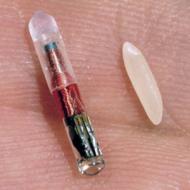This is a face of someone – and yes, I used that word deliberately – in a very high kill shelter in Lancaster, CA, LA County.

The faces of some of those impounded there are on facebook – it breaks my heart how many get killed, and how many just needed another day or 2 to arrange for rescue. I think if I lived around there, I would not even have my own dog, just become a puller.
In any case, after a few days, they finally scanned this absolutely gorgeous girl. Tags can fall off but she is microchipped – GIVING HER MORE DAYS – and a second chance at life – even if the owner is not found. I vote for microchipping – and keeping your info updated. Microchipped dogs have a much higher chance of being reunited with their owners – and it buys them time at shelters.
Lost pets that are not microchipped have only a 13 percent chance of being reunited with their owners. When they have microchips they have a 74 percent chance of going back home. California legislators are considering a law that will require every cat or dog adopted at an animal shelter to be implanted with a lifesaving microchip.
Impound Number: A4316171
Mail to a friend
This is what someone said about her
really sweet girl…in with a golden retriever so dog friendly…smaller husky…just love her
Impound Date:
7/25/2011 10:37:08 PM
Sex
Female
Primary Breed:
SIBERIAN HUSKY
Age:
6 Years and 0 Months
Location:
Lancaster
Laurie Hoskins What the heck..the CTA didn’t show up–that’s a question not a definitive statement–the CTA was supposed to come TODAY AUGUST 1ST and she’s still listed!! Please keep cross posting her and find her a way out of there!! Rhonda Hallden –have you heard anything on this girl? M Saving Alife ..it doesn’t look like the CTA showed up!!!
15 hours ago · Like
posted on her thread today: Ok everyone take a deep breath 🙂 UPDATE! Shelter people are complete imbacils! CTA canceld but guess what?.. A week later turns out the dog has microchip, really?.. Heloooo! So the dog is on hold till July 12th now. Great, what a waste of time. Do these people get paid $2 an hour and just dont wanna do anything or what is it? I have no comment here… duuuh…
6 hours ago · Like
Felicia Wilkey Grrr! Ok, since she’s microchipped, has the shelter bothered to call the owner?!? I can only hope that the owners are beside themselves trying to find her. Otherwise, well, I won’t even go there.
4 hours ago · Like
Felicia Wilkey I’m thinking July was a typo and should be August.
4 hours ago · Like
While she is waiting for the owner to step forward, she has someone wanting to take her home.
 If there was identifying info like a chip or tag, they have to hold the animal for 10 BUSINESS DAYS. If she came in on the 25th with either, “10 days” would be 8/5 – no surgeries on weekends, so available 8/8.
If there was identifying info like a chip or tag, they have to hold the animal for 10 BUSINESS DAYS. If she came in on the 25th with either, “10 days” would be 8/5 – no surgeries on weekends, so available 8/8.
This is her impound picture
On microchipping (from various sources on the www.)
 Microchipping your cat or dog is the best way to ensure you have every chance of being reunited should they go missing.
Microchipping your cat or dog is the best way to ensure you have every chance of being reunited should they go missing.
The size of a grain of rice, the microchip is inserted under the animals skin between the shoulder blades and can be easily detected with a special scanning device. These devices are kept at vets and rescue shelters and will detect the chip and it’s unique identification code.
The national microchip database can then be checked and a quick telephone call can reunite owner and pet.
Microchip. Microchipping involves the injection of a tiny chip (about the size of a grain of rice) just under your pet’s skin between the shoulder blades. For those who are skeptical of microchips, here is a little information that may put your mind at ease. The microchip is housed in a type of glass made to be compatible with living tissue, so it won’t affect your pet adversely.
The process of inserting a microchip is similar to when your pet receives a shot and no anesthesia is necessary for implantation. Once in place, the microchip can be detected immediately by shelter staff with a handheld device that uses radio waves to read the chip. This device scans the microchip, and then displays a unique alphanumeric code that will be entered into a database with your information. Most animal shelters check every stray pet that comes through their doors to see if they have a microchip. If a microchip is found, the shelter contacts the database to find your information. Microchips are said to last 20 years, so there is no need to remove or replace it in the duration of a pet’s lifetime.
Although microchipping seems to be catching on, according to the Coalition for Reuniting Pets and Families, less than 5 percent of all pets are microchipped. Although microchips are a lifesaver, don’t rely on it as your pet’s only means of identification. While your local shelter may have a microchip scanner, your neighbor most likely doesn’t, so a collar with an identification tag is a great addition to the microchip.
It uses a “radio frequency” that allows a special scanner to read a number that is identified with a specific pet.
Opponents of the bill say that chips move around on a dog’s body and cannot always be detected. And some accuse microchips of causing tumors and cancer.
Supporters acknowledge that chips can “migrate on an active dog,” but can be found; …”it just means scanning a wider swath.” The AP also interviewed four veterinarians about microchips causing cancer and all of them stressed that “problems are unlikely when chips are inserted properly.”
Lawmakers are optimistic SB 702 will pass in mid-August.